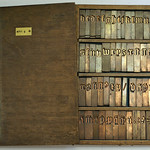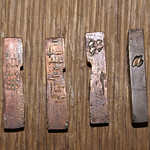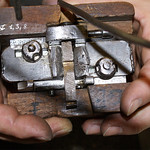Commonly letters are treated as skeleton forms on which a certain contrast-flow is applied. According to Sumner Stone in an article on Hans Eduard Meier’s Syntax-Antiqua in Fine Print On Type (London, 1989) ‘It seems doubtful that Renaissance scribes thought of their letterforms as anything but organic units, but the abstractions to a skeleton form do capture the essence of the letters […]. The concept of an essential linear form is not unknown in the lettering pedagogy of this century. It is mentioned by Edward Johnston in Formal Penmanship, and was used extensively by the Austrian lettering teacher Rudolf Von Larisch and his student Friedrich Neugebauer. Father Catich also used it in his teaching of letterforms.’
So, one could argue that capitals, uncials, book-hand minuscules, and cursive minuscules find their origin in the movements that result in a single heart (‘skeleton’) line, on which a certain contrast sort (‘translation’, ‘expansion’, or a combination of these), contrast, and subsequent contrast flow (either or not influenced by rotation) are applied. However, another point of view is that the letter shapes find their origin in (the restrictions of) the tool that was used to make the movements. In case of the Humanistic minuscule and cursive minuscule variants from the Renaissance, the pen in question was the broad nib, as was the case with their prototype from the 8th century, the Carolingian minuscule.

Different vector angles applied on a static heart line
The image above show that when translation is applied on a fixed heart line of a book-hand minuscule n, the construction changes significantly depending on the vector angle. The position of the highest contrast in the arch changes position in case the vector angle is changed. Due to the conventions one would expect the highest contrast in the arch nearby or even attached to the stem. So, the heart line works well for the n on the right, but not for the other ones, because it finds its origin in a minuscule n that was written with a vector angle of 30 degrees.

Different vector angles and center lines adjusted accordingly
When writing such a book-hand minuscule n, normally (but not necessarily) the pen is lifted and the heart lines of the stem and arch are not connected. When stem and arch have to be connected at the point of the highest possible contrast (defined by the thickness of the nib), the heart line should represent/follow the ‘vector bridge’, i.e., the angle and width of the vector (nib-width) applied.

The letters x,y,z tweaked into the primary harmonic model
Combining construction methods
In the primary harmonic model (phm) the letters s, k, and v–z range are lacking. To fit these letters into the phm, quite some tweaking is necessary. One could conclude that therefore the model is to much restricted, or is even incorrect to represent the Latin book-hand minuscules. In fact, it is not strange that the letters in question cannot be defined faultlessly with the phm; as everyone who writes with a broad nib knows, these letters have a different morphological background and they need some tweaking and bending to make them fit the other ones.

Vector applied on the heart line of the capital A
The k and the v-z range, but also the s are directly derived from the capitals, and therefore represent a different harmonic model. Capitals do find their origin in heart lines, which were eventually vectored by the Romans. The geometric and relatively simple shapes of the capital letters make it possible to apply broad-nib effects with different vector angles.
Notes on the construction of serifs
There is a simple relation between the top and bottom serifs of the letters. Noordzij suggests in De staart van de kat (1988)* that the triangular upper serif of, for example, the lowercase letter i can theoretically be divided into two identical parts by a horizontal line. This can actually be pushed a step further.

The relationship between top and bottom serif defined
The bottom serif is in theory made of half the top serif. If the serifs are straight triangular shapes, the top half of the top serif is identical to the bottom serifs. If the bottom half of the top serif is curved, the bottom serif is a mirrored copy of this curved part (see image above). To maintain the total weight of the top serif, the top half can be copied to the right side of the stem bottom. In case the pen (vector) angle changes, the serifs will change too. The steeper the pen angle, the more weight will be in the arches and subsequently the more weight will be in the serifs. Increment of the contrast is achieved by making the thick parts of a letter thicker.
This way of constructing serifs has been implemented in LeMo. A future addition will be the ‘disconnection’ of the serifs of the basic model afterwards, by using the ‘general’ parameters and the subsequent applying ‘independent’ general parameters, i.e., for all serifs, or even local ones (that is per [part of the] serif).
* ‘The tail of the cat’




